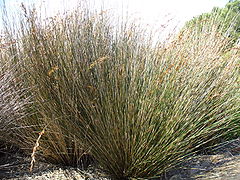Difference between revisions of "Thamnochortus insignis"
From Gardenology.org - Plant Encyclopedia and Gardening Wiki
Jump to navigationJump to search| Line 5: | Line 5: | ||
|common_name=Dekriet, Thatching reed | |common_name=Dekriet, Thatching reed | ||
|habit=grass | |habit=grass | ||
| + | |habit_ref=Wikipedia | ||
|Min ht box=6 | |Min ht box=6 | ||
|Min ht metric=ft | |Min ht metric=ft | ||
|Max ht box=7 | |Max ht box=7 | ||
|Max ht metric=ft | |Max ht metric=ft | ||
| + | |height_ref=Flora - A Gardener's Encyclopedia | ||
|Min wd box=6 | |Min wd box=6 | ||
|Min wd metric=ft | |Min wd metric=ft | ||
|Max wd box=7 | |Max wd box=7 | ||
|Max wd metric=ft | |Max wd metric=ft | ||
| + | |width_ref=Flora - A Gardener's Encyclopedia | ||
|origin=S Africa | |origin=S Africa | ||
| + | |origin_ref=Wikipedia | ||
| + | |lifespan=perennial | ||
| + | |life_ref=Wikipedia | ||
|exposure=sun | |exposure=sun | ||
| + | |sun_ref=Flora - A Gardener's Encyclopedia | ||
|flower_season=early summer, mid summer, late summer | |flower_season=early summer, mid summer, late summer | ||
| + | |flower_ref=Flora - A Gardener's Encyclopedia | ||
|Min Temp Num=3 | |Min Temp Num=3 | ||
|Temp Metric=°C | |Temp Metric=°C | ||
Latest revision as of 22:02, 26 April 2010
| Habit | grass
| |
|---|---|---|
| Height: | ⇕ | 6 ft"ft" can not be assigned to a declared number type with value 6. to 7 ft"ft" can not be assigned to a declared number type with value 7. |
| Width: | ⇔ | 6 ft"ft" can not be assigned to a declared number type with value 6. to 7 ft"ft" can not be assigned to a declared number type with value 7. |
| Lifespan: | ⌛ | perennial |
| Origin: | ✈ | S Africa |
| Bloom: | ❀ | early summer, mid summer, late summer |
| Exposure: | ☼ | sun |
|---|---|---|
| Minimum Temp: | ☃ | 3°C37.4 °F <br />276.15 K <br />497.07 °R <br /> |
| USDA Zones: | 8 to 10 |
|
insignis > |
Thamnochortus insignis is a species of grass-like restio of the family Restionaceae.
Plants are tall, grass- or reed-like tussocks with a diameter of 500 mm to 1 metre at the base and a spread of 3 metres or more at the top and up to 2,5 m tall. Male and female plants are separate and very similar when they are not flowering.
Cultivation
It is excellent in pots and can be easily established outside in mild districts (in the Northern Hemisphere). It is hardy to -3ºC.[1]
Propagation
The seed comes in the form of a tiny nutlet inside the old flower, which by this stage has formed two small wings. The seeds are produced in very large quantities by each female plant, but are not all viable; a large number of nutlets are empty inside.
Pests and diseases
Varieties
Gallery
References
External links
- w:Thamnochortus insignis. Some of the material on this page may be from Wikipedia, under the Creative Commons license.
- Thamnochortus insignis QR Code (Size 50, 100, 200, 500)

